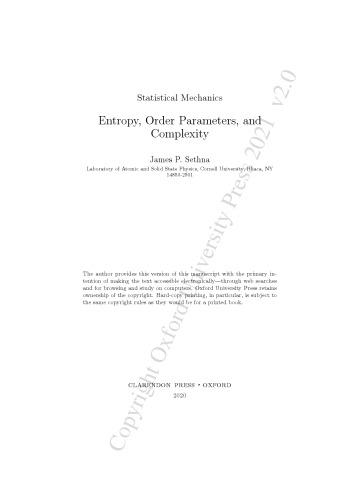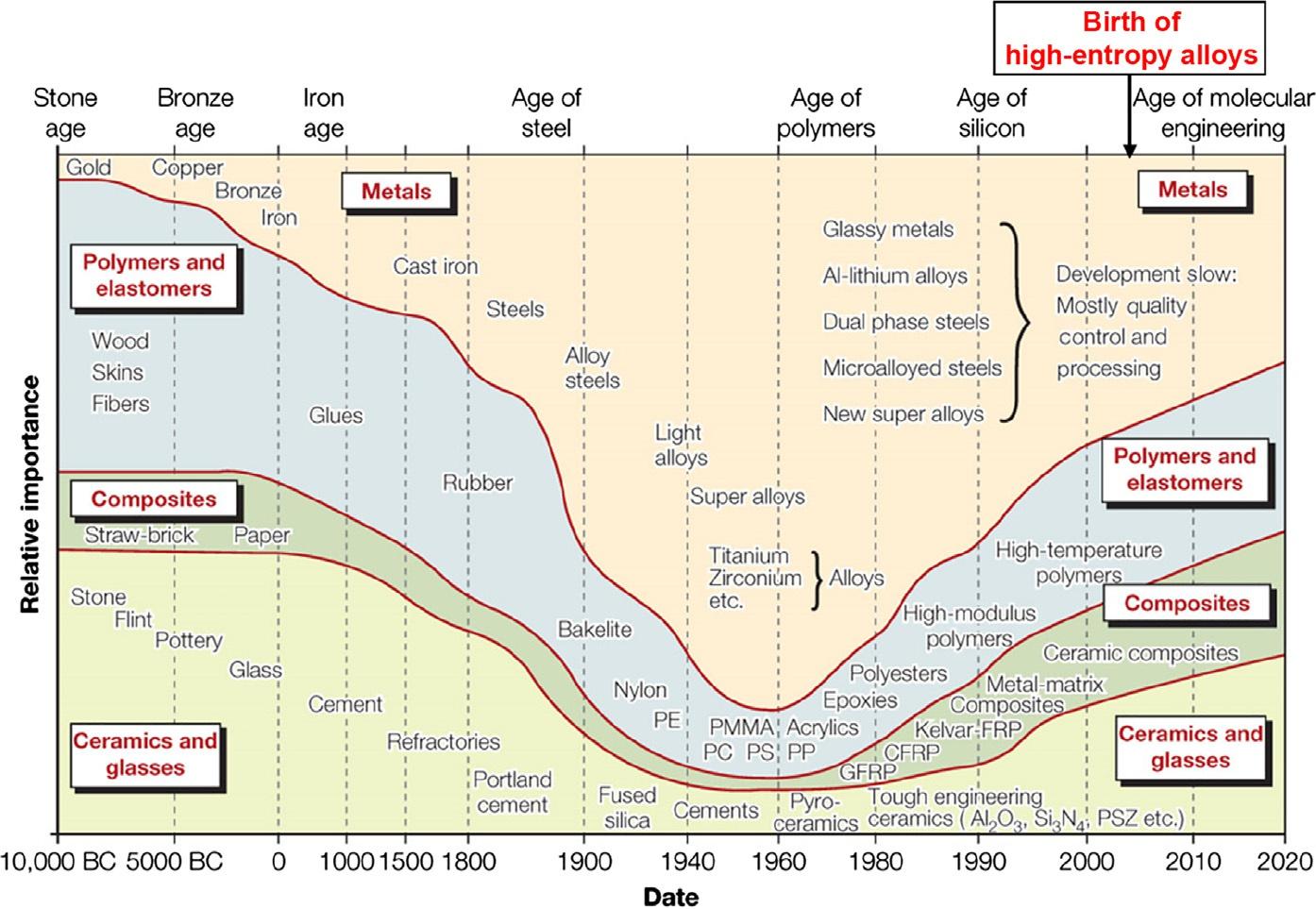https://ebookmass.com/product/high-entropy-alloyssecond-
Instant digital products (PDF, ePub, MOBI) ready for you
Download now and discover formats that fit your needs...
The High Stakes Rescue: A K9 Handler Romance (Disaster City Search and Rescue, Book 29)
1st Edition Jenna Brandt https://ebookmass.com/product/the-high-stakes-rescue-a-k9-handlerromance-disaster-city-search-and-rescue-book-29-1st-edition-jennabrandt/ ebookmass.com
ENTROPY ANALYSIS IN THERMAL ENGINEERING SYSTEMS 1ST Edition Yousef Haseli
https://ebookmass.com/product/entropy-analysis-in-thermal-engineeringsystems-1st-edition-yousef-haseli/
ebookmass.com
Statistical mechanics : entropy, order parameters, and complexity 2nd Edition Sethna
https://ebookmass.com/product/statistical-mechanics-entropy-orderparameters-and-complexity-2nd-edition-sethna/
ebookmass.com
Automotive Service: Inspection, Maintenance, Repair Book 6th Edition Tim Gilles
https://ebookmass.com/product/automotive-service-inspectionmaintenance-repair-book-6th-edition-tim-gilles/
ebookmass.com
(ENCHANTED CHRONICLES OF CRESCENT CITY Book 1) Amy Armstrong https://ebookmass.com/product/healing-hearts-a-sweet-paranormalromance-novel-enchanted-chronicles-of-crescent-city-book-1-amyarmstrong/
ebookmass.com
Invitation to Psychology 7th Edition – Ebook PDF Version
https://ebookmass.com/product/invitation-to-psychology-7th-editionebook-pdf-version/
ebookmass.com
Beautiful Nightmares (Fortuna Sworn Book 4) K.J. Sutton https://ebookmass.com/product/beautiful-nightmares-fortuna-swornbook-4-k-j-sutton/
ebookmass.com
Child Development 9th Edition, (Ebook PDF)
https://ebookmass.com/product/child-development-9th-edition-ebook-pdf/
ebookmass.com
Computational Frameworks. Systems, Models and Applications 1st Edition Edition Mamadou Kaba Traore (Eds.)
https://ebookmass.com/product/computational-frameworks-systems-modelsand-applications-1st-edition-edition-mamadou-kaba-traore-eds/
ebookmass.com
Interference in a Digital Age 1st Edition Jens David Ohlin (Editor)
https://ebookmass.com/product/defending-democracies-combating-foreignelection-interference-in-a-digital-age-1st-edition-jens-david-ohlineditor/
ebookmass.com
High-EntropyAlloys High-EntropyAlloys SecondEdition
B.S.Murty
DepartmentofMetallurgicalandMaterialsEngineering, IndianInstituteofTechnologyMadras,Chennai,India
J.W.Yeh
DepartmentofMaterialsScienceandEngineering, NationalTsingHuaUniversity,Hsinchu,Taiwan
S.Ranganathan
DepartmentofMaterialsEngineering, IndianInstituteofScience,Bangalore,India
P.P.Bhattacharjee
DepartmentofMaterialsScienceandMetallurgicalEngineering, IndianInstituteofTechnologyHyderabad,India
Elsevier
Radarweg29,POBox211,1000AEAmsterdam,Netherlands TheBoulevard,LangfordLane,Kidlington,OxfordOX51GB,UnitedKingdom 50HampshireStreet,5thFloor,Cambridge,MA02139,UnitedStates
© 2019ElsevierInc.Allrightsreserved.
Nopartofthispublicationmaybereproducedortransmittedinanyformorbyanymeans, electronicormechanical,includingphotocopying,recording,oranyinformationstorageand retrievalsystem,withoutpermissioninwritingfromthepublisher.Detailsonhowtoseek permission,furtherinformationaboutthePublisher’spermissionspoliciesandour arrangementswithorganizationssuchastheCopyrightClearanceCenterandtheCopyright LicensingAgency,canbefoundatourwebsite: www.elsevier.com/permissions.
Thisbookandtheindividualcontributionscontainedinitareprotectedundercopyrightbythe Publisher(otherthanasmaybenotedherein).
Notices Knowledgeandbestpracticeinthisfieldareconstantlychanging.Asnewresearchand experiencebroadenourunderstanding,changesinresearchmethods,professionalpractices,or medicaltreatmentmaybecomenecessary.
Practitionersandresearchersmustalwaysrelyontheirownexperienceandknowledgein evaluatingandusinganyinformation,methods,compounds,orexperimentsdescribedherein. Inusingsuchinformationormethodstheyshouldbemindfuloftheirownsafetyandthesafety ofothers,includingpartiesforwhomtheyhaveaprofessionalresponsibility.
Tothefullestextentofthelaw,neitherthePublishernortheauthors,contributors,oreditors, assumeanyliabilityforanyinjuryand/ordamagetopersonsorpropertyasamatterofproducts liability,negligenceorotherwise,orfromanyuseoroperationofanymethods,products, instructions,orideascontainedinthematerialherein.
LibraryofCongressCataloging-in-PublicationData
AcatalogrecordforthisbookisavailablefromtheLibraryofCongress
BritishLibraryCataloguing-in-PublicationData
AcataloguerecordforthisbookisavailablefromtheBritishLibrary ISBN:978-0-12-816067-1
ForinformationonallElsevierpublications visitourwebsiteat https://www.elsevier.com/books-and-journals
Publisher: MatthewDeans
AcquisitionEditor: ChristinaGifford
EditorialProjectManager: AliAfzal-Khan
ProductionProjectManager: AnithaSivaraj
CoverDesigner: AlanStudholme
TypesetbySPiGlobal,India
Forewordforthesecondedition Metallurgyhasbeenleadinghumancivilizationfromtimeimmemorial.Manknew howtoextractmetalsfromores,howtoalloymetalstomakethemsuitableforspecific needs,andhowtopreparehigh-puritymetalsandcompoundsforelectronicapplications.Lookingbackintothelastcentury,itmaybesaidthatdevelopmentsinmetallurgyandmaterialssciencehaveplayedasignificantroleinseveralareasand impactedtheeconomyandwell-beingofpeople.Everyotherbranchofscience andengineeringhasdependedonadvancesinmetallurgytobeappliedinitsdomain. Developmentofsuperalloysforjetengineapplications,developmentofcarboncarboncompositesforwingsofwide-bodiedaircrafts,high-temperaturesuperconductors,etc.areonlyafewexamplestoquote.Itshouldalsobementionedherethatthe availabilityofexcellenthigh-resolutiontechniqueshascontributedimmenselytothe understandingofthescienceandtechnologybehindthesedevelopments,particularly fromthepointofviewofstructure-propertycorrelationscoupledwithphase transformations.
Lookingatthepresentcenturyandtheresearchareascoveredinthelastdecadeand ahalf,itisnotanunderstatementifIsaythatthetopicof“High-EntropyAlloys” (HEAs)aka“MultiprincipalComponentAlloys”hasbeenthemainattractionofseveralresearchgroupsallovertheworld.ThenumberofpublicationsonHEAsinrecent yearsin ActaMaterialia hasfarexceededthatofanyothertopic.Iamdelightedto writethisForewordfortheSecondEditionofthefirstbookon High-EntropyAlloys TheForewordfortheFirstEditionwaswrittenbyBrianCantoroftheUnited Kingdom.
ThebasicdifferencebetweenconventionalsinglebasealloysystemsandHEAis thatthelatterdealswithcompositionsatthecenterofamulticomponentphasediagram.Severalfactorsleadtotheformationofsingle-phaseHEA.Yeh,independent inventorofHEA,attributedthistofourcoreeffects:highentropy,sluggishdiffusion, highlatticedistortion,andcocktaileffects.Severalofthealloyschosenbyhimturned outtobesinglephase,butsomerevealedadditionalphasesonexaminationbyhighresolutiontechniques.Thus,therearechallengesinunderstandingtheevolutionof phasesinHEAs.However,HEAshavegivenimpetusfortheevaluationofmulticomponentphasediagrams,andnewmulticomponentthermodynamicdatabases arebeingdevelopedbyagenciessuchasThermo-Calc.Thesealloyshavealsoopened newavenuestoprobeintodiffusionandmechanicalbehaviortounderstandthedislocationdynamicsandphasetransformationsinmulticomponentsystems.
EarlyworkonHEAsbyseveralgroupswasmainlyfocusedon3-dtransition metalspartlyduetoourfamiliaritywiththesemetals,stainlesssteels,andsuperalloys. ThesecrystallizedinFCCorBCCstructures.Themechanicalpropertiesof3-dHEAs
wereonlymarginallybetterthantheexistingalloys,buttheiroxidationandcorrosion resistanceinafewcaseswerebetterthanconventionalmaterials.Improvementsin strengthinFCCalloyswereobtainedbyparticulatestrengthening,whileductility inBCCwasbroughtinbyeutecticmicrostructure.However,theso-calledCantor alloycontainingFeCrMnNiCoshowedhighstrengthandhighductilityoverawide rangeoftemperatures.Thisleadsonetoconcentrateonthedeformationmechanisms thatoperateinHEAsforabetterdesignofthealloys.
Withtheinteresttodevelopalternativestosuperalloys,whichhavereachedasaturation,afewresearchersfocusedtheirattentiononrefractoryHEAscontainingHf, Nb,W,Cr,Zr,etc.astheyexpectedthesetoyieldbetterhigh-temperatureproperties. Whilethestrengthlevelswerehigh,ductilitywasfoundtobelow.Itwasrealizedthat equiatomiccompositionsarenotlikelytoyieldthedesiredpropertiessuitableforspecificapplicationsandcompositionsweretailoredtoobtaintherequisiteproperties. Ifeelonehastobeinnovativeandintuitiveinselectingthecompositionsofalloys. Possibly,minoradditionsofsomeelementssuchasC,B,andREinHEAsmayyield improvedproperties.Iexpectgreateremphasisbyresearchersonthisaspectinthe comingyears.
Thelastchapterinthisbookisonapplication.Thereshouldbeaconcentratedeffort ontheuseofHEAcoatingsforenvironmentalprotection,astheunderlyingstructureis wellestablishedandHEAsmayextendtheirusefullife.Atthesametime,focused emphasisisneededtodeveloprefractoryHEAsastheiruseislikelytoincrease theefficiencyofenergysystemsandatthesametimereducepollutionlevels.The industries,R&Dlaboratories,andacademicinstitutionsshouldjoinhandsinbringing HEAstothemarketasearlyaspossible.
Thefirsteditionofthebookbroughtoutin2014had10chaptersandwrittenby threeauthors.Ithasbeenexpandednowbyaddingthreemorechapters,withanadditionalauthor.Alltheappendixeshavebeenupdated.Inaddition,Ishouldalsopoint outthat Chapter5 includesinformationontheuseof“ArtificialIntelligencein HEAs,”whichwouldbeusefultoresearchersinthefield.
R.Krishnan
FormerDirector,GasTurbineResearchEstablishment,Bengaluru,India
Forewordforthefirstedition Inthe1970s,Ibecameexcitedabouttheideaofmulticomponentalloys.Irealizedthat thematerialsweusearealmostallbasedonasinglecomponentwithaprimarypropertyandanadmixtureofsmallamountsofothercomponentstoprovidesecondary properties.Effectively,allourknownmaterialsareatthecornersandedgesofamulticomponentphasediagramconsistingofallpossiblecomponents.Thismeansthat thereareavastnumberofpossiblematerialsinthemiddleofthisphasediagramthat haveneverbeeninvestigated.Itturnsoutthatthisunknownfieldofmaterialsistruly enormousandthenumberofunexploredmaterialsismanytimesgreaterthanthenumberofatomsintheuniverse.
Thisexplainswhywekeepdiscoveringexcitingnewmaterials:high-temperature superconductors,glassyalloys,quasicrystals,compoundsemiconductors,andsoon. Andwewillkeepfindingexcitingnewmaterialsaslongaswehavethecourageas experimenterstotryinnovative,newmixturesofconstituents.InowtelleveryPhD studentinmaterialssciencetobeaggressiveandambitiousinexploringthisamazing arrayofpotentialnewmaterials.
Inthe1970s,Ifoundithardtopersuadeotherpeopletobesimilarlyenthusedbymy ideasonthetopicofmulticomponentalloys.Icouldnotgetfunding,andIcouldnot getresearchcolleaguestoundertakepreliminaryexperiments.Everyonewantedto workinmuchbetterknownfields.Everyonewasveryconservative.Finally, Ipersuadedayoungundergraduatestudent,AlanVincent,todopreliminarywork. Heimmediatelyfoundexcitingresultsincludingthefirsthigh-entropyalloys.Nearly 20yearslater,Ipersuadedanotheryoungundergraduatestudent,PeterKnight,to repeatthework.Andfinally,acoupleofyearslater,mylong-standingresearchcolleague,IsaacChang,repeatedtheexperimentsforathirdtimebutmorecarefullyand withmoretimetodocumenttheresultsfullyandinapublishableway.Wepresented theresults,firstfoundbyAlanVincentin1979,ataconferencein2002,whichwas publishedin2004,morethan25yearssincemyfirstidea.Inparallel,Professor S.Ranganathan(myoldfriend,Rangu)andProfessorJ.W.Yeh(mynewfriend, Jien-Wei)publishedindependentlypaperson,respectively,materialcocktailsand high-entropyalloys,closelyrelatedandessentiallysimilarconceptstomyideaofmulticomponentalloys.
Inthelastfewyears,asaconsequenceoftheoutstandingcontinuingworkbyJienWei,thefieldofmulticomponentandhigh-entropyalloyshastakenoff,withliterally hundredsofpublicationseachyear.Mostnotably,Vincent,Knight,Chang,and Idiscoveredinthelate1970sasingleFCCsolidsolutionconsistingofsixcomponents inequalproportions,namely,FeCrMnNiCo.Thisalloyhasbeenshowntohaveoutstandingmechanicalproperties,withhighstrengthandhighductility.Irealizedinthe
late1970sthatthemechanicalbehaviorofthismaterialwouldbeveryunusual.Metal andalloymechanicalpropertiesdependprimarilyonthebehaviorofdislocationsand howtheymoveinresponsetostress,buttheconceptofadislocationasalinedefect withaconsistentcorestructurebecomescomplexwhentherearemanydifferentcomponentsdistributedonasinglelattice.
ProfessorsMurty,Yeh,andRanganathanhavenowwrittenabookonthisnew groupofmaterials.Thebookcoversthestructure,processing,andpropertiesofthe materials,insofaraswehavebeenabletoexplorethem.Somemulticomponentalloys aresolidsolutionswithhighentropy.Somearenot.Ineithercase,therearewonderfullyexcitingnewstructuresandpropertiestobefound.Thisbookisthefirstabout thisfield.Itcontainsmanyvaluableandinterestinginsights.Butultimately,itcan onlyhintatthefullrangeofnewmaterialsthatremaintobediscovered.Theauthors shouldbecongratulatedondoinganimportantjobthatwillhelpusonourexciting, exploratoryjourneyintothematerialsofthefuture.
Prof.BrianCantor ViceChancellor,UniversityofBradford,UnitedKingdom
Prefaceforthesecondedition Thehigh-entropyalloy(HEA)fieldhasbeengrowingleapsandbounds.ThefirsteditionofHEAbookhasbeenpublishedin2014,mostlybasedonthepublicationsuntil 2013.Thenumberofpublicationsinthelast5years(2014–June2018)issixtimes (morethan2600)thatofthepublicationsthathavecomeoutinthefirstdecadeof thefield(about400from2003to2013).Thishasnecessitatedthereleaseofthesecond editionofthebook.Thecurrenteditionaddsonthenewresearchthathasbeenbrought outinthelast5yearstothefirstedition.
Whilethenumberofnewequiatomiccompositionsthathavebeeninvestigatedin thelast5yearshasnotbeenmany,researchersrealizedtheneedtodevelopnonequiatomiccompositions(andwithminoradditionsofcertainelements)tobring outsignificantimprovementsinvariousproperties.NewsubclassesinHEAssuch aseutecticHEAs,HEAsuperalloys,TWIP-andTRIP-typeHEsteels,dual-phase HEAs,lightHEAs,andHEAoxideshavebeendevelopedinrecentyears.
TheeffortsonpredictingthephaseformationinHEAsthroughthermodynamic calculationsandattemptstocalculatemulticomponentphasediagramsthrough CALPHADapproacheshavesignificantlygrown.Thermo-Calchasbroughtouta newHEAthermodynamicdatabase(TCHEA)toassistresearchersinthecalculations inmulticomponentspace.Inadditiontofirstprinciplecalculations,researchersalso startedexploringartificialintelligenceasatooltounderstandthebehaviorofHEAsin termsofphaseformationandproperties.
InadditiontotheexistingroutesforthesynthesisofHEAs,newroutessuchas carbothermalshocksynthesistopreparenanoparticlesofHEAsand3-Dprinting throughadditivemanufacturingroutesdevelopedrecentlyhavewidenedthescope ofthefield.Inadditiontothetraditionalapplications,HEAsarebeingexploredfor avarietyoffunctionalapplicationssuchasmagnetic,thermoelectric,andbiomedical applications.
Itisalsopertinentheretosaythatanumberoflarge-scaleinitiativesarebeingtaken invariouscountriesthroughpublicandprivatepartnershipstobringoutbothscientific andtechnologicaladvancesinthisfield.Inrecentyears,almosteveryconferencein metallurgyhasspecialsessionsonHEAs.Inaddition,exclusiveconferences/symposia/workshopsarebeingconductedregularlyinthisfieldtosharetheknowledgebeing gainedbyvariousresearchers.MentioncanbemadeofbiennialInternationalConferenceonHigh-EntropyMaterials(ICHEM),thefirstoneheldinTaipei,Taiwan,in 2016andthesecondonebeingheldinJeju,Korea,inDecember2018.InIndiaalso, asimilarbiennialInternationalWorkshoponHigh-EntropyMaterials(IWHEM) startedin2015atChennaiandsubsequentlyatHyderabadin2017,andthenext onewillbeheldinKanpur.Awebsite(https://mme.iitm.ac.in/hea/)isbeingmaintainedbythegroupofB.S.Murtyintheresearchactivitiesinthisfield,withparticular
emphasisonIndianresearchactivity.Thiswebpageisupdatedmonthly,andonecan getalistofup-to-datepublicationsinthisfieldfromthissource. ThissecondeditionoftheHEAbookbringsoutalltherecentadvancesinthis excitingnewclassofalloys.Weareconfidentthatitwouldexcitethereader.
B.S.Murty, J.W.Yeh, S.Ranganathan, P.P.Bhattacharjee
Prefaceforthefirstedition Alloystraditionallyhavebeenbasedonasolventelementtowhichvarioussolute atomsareaddedforimprovingspecificproperties.Thus,alloysareusuallynamed afterthemajorelementinthealloy,forexample,Fe-base,Al-base,Cu-base, Mg-base,andNi-basealloys.Twopeople,inrecenttimes,havechangedthewaypeoplelookatalloys,andtheyareProf.BrianCantorandProf.Jien-WeiYehbycoming upwithequiatomicandnonequiatomicmulticomponentalloys.Incidentally,though eachofthemstartedworkingonthesealloysindependentlyatdifferenttimes(Cantor startingin1981andYehstarting1996),theirworkcametoopenliteratureinthesame year,2004.Interestingly,evenbeforethepapersofthesetwopioneersgotpublishedin 2004,Prof.S.Ranganathanfelttheimportanceofthisnewclassofalloysandwrote abouttheminhisclassicpaper“Alloyedpleasures:multimetalliccocktails”in2003, whichhasbeencitedmorethan100timesnowasthefirstpublicationonthisclassof alloys.
Yehchristenedthesealloysas“high-entropyalloys(HEAs),”rightlyso,astheconfigurationalentropyofthesealloysisexpectedtobeveryhighattheirrandomsolution states.Suchahighentropyisexpectedtoletthealloystendtoformsimplesolidsolutions(crystallineoramorphous)ratherthancomplexmicrostructureswithmanycompounds.Theconcepthascaughttheattentionofmanyinthelastonedecadewitnessed about400–500papersbeingpublishedonHEAswithvariouselementalcombinations. Twomajorobservationscanbemadefromallthiswork,namely,thealloysdoform simplesolidsolutionsinmostofthecases,andthenumberofphasesobservedinthese alloysismuchlessthanthemaximumpredictedfromtheGibbsphaserule.
Therearealsoclearindicationsthatthehighentropyinthesemulticomponent equiatomicandnonequiatomicalloysisnotabletoactlikeaglueholdingalltheatoms togetherinasinglesolidsolution,andtherearereportsontheformationsoftwoor morephasesinwhichintermetallicphasesandevensegregationofcertainelements mightform.Thiscouldberelatedwiththevariousthermodynamicandkineticfactors. Therehasbeenintenseactivityinthepastfewyearstopredictthephasesthatcanform insuchmulticomponentalloysthroughvariousmodelingapproachesincludingintegratedcomputationalmaterialsengineering(ICME)usingvarioustoolssuchas CALPHAD, ab-initio,moleculardynamics,MonteCarlo,andphase-fieldapproaches, whichhavebeensupportedbyMaterialsGenomeInitiative(MGI).
Besidesthesciencecuriosity,researchersalsowishthatHEAscansubstituteconventionalmaterialsinadvancedapplicationssothatthelimitationsinservicelifeand operationconditionscouldbeovercomebyprovidingsuperiorperformance. Anumberofprocessingroutes,includingconventionalmeltingandcasting,mechanicalalloying,variouscoatingtechniques,andevencombinatorialmaterialsscience approaches,arebeingusedtosynthesizeandprocessthisnewclassofalloys.There
Acknowledgmentsforthesecond edition TheauthorsaregratefultoDr.R.Krishnanforreadilyagreeingtowriteaforewordfor thesecondeditionofthebook.Hehasalsomadeimmensecontributionsbycritically examiningeachchapterandhelpingtoimproveitsquality.Wearealsogratefultoall theauthorsofvariouspublicationsthatwerefertointhisbook.
Prof.Murtywouldliketospeciallythankhisgroupmembers,Dr.Nagini,Dr. Satish,Dr.Ram,Gopi,LavaKumarandAdil,whohavehelpedincollectingthearticlesandgoingthroughthewrite-uptobringittogoodshape.Amongall,Lava Kumar’shelpisimmense,andProf.Murtyisindebtedtohimforit.
Dr.PinakiBhattacharjeewouldliketothankhisgroupmembers,Seelam, Narayanswamy,Veerasham,andJaydeep,fortheirimmensehelpincollectingtherelevantresearchpapers.
Prof.Yehwouldliketothankhisresearchassistant,Hsuan-ChuChen,forupdating thestatisticalanalysisofpublishedSCIandEIpapersonhigh-entropyalloysand relatedmaterials.HealsothankshisPhDstudent,Ko-KaiTseng,forpreparing newfigures.
Prof.RanganathanisthankfultoMs.S.VaralakshmiandDhairyasheelPatilfor theirhelpincompilingthechapters.
B.S.Murty, J.W.Yeh, S.Ranganathan, P.P.Bhattacharjee
Acknowledgmentsforthefirst edition TheauthorsaregratefultoProf.BrianCantorforreadilyagreeingtowriteaforeword forthebook,inspiteofhishecticscheduleasViceChancellorofUniversityofBradford, theUnitedKingdom.Wearealsohighlyindebtedtoalltheauthorsandpublishersof variousworksthatwereferto,whohavesignificantlyimprovedthequalityofthebook.
Prof.Murtywouldliketospeciallythankhisgroupmembers,Mayur,Guruvidyathri, Anirudh,Arul,Ameey,andDr.Sanjay,whohaveuntiringlyhelpedatvariousstages. Meetingthedeadlineofthepublisherwouldnothavebeenpossiblewithouttheirhelp. Hewouldalsoliketogratefullyacknowledgethecollaborationwithhisstudents, Varalakshmi,Praveen,Pradeep,Sriharitha,Ashok,Durga,andRaghavan,and collaboratorsDr.RaviSankarKottada,Prof.M.Kamaraj,andProf.K.C.HariKumar ofIITMadras;Dr.SheelaSingh,Dr.N.Wanderka,andProf.J.BanhartofHelmholtzZentrumBerlin;andProf.D.RaabeofMax-Planck-InstitutfurEisenforschung, D€ usseldorf.Hethanksallofthemforjoininghiminthisexcitingjourneysofar. Heisalsoindebtedtohisfamilymembersfortheirpatienceandcontinuoussupport.
Prof.Yehwouldliketothanktwoimportantgroupmembers,Prof.Su-JienLinand Prof.Swe-KaiChen,fortheirlong-termcontributionsintheresearchonhigh-entropy alloyssince1995.HealsoexpressessincerethankstoProfs.Tsung-ShuneChin,JanYiawGan,Tao-TsungShun,Chun-HueiTsau,Shou-YiChang,TungHsu,andWenKuangHsuandallgraduatedstudentsfortheirsignificanteffortsandcontributionsin HEA-relatedresearch.Inaddition,hespeciallythanksDr.Chun-MingLinandPhD studentChien-ChangJuanfortheirhelpinsearchingrelatedpapers,plottingfigures, andprovidingsuggestionsforthisbook.Finally,healsogratefullythankshisbeloved wifeanddaughtersforalltheirencouragementandsupportsduringwritingthisbook.
Prof.Ranganathanrecordshisgratitudetonumerousteachers,colleagues,and studentswhoinstilledhimanabidinginterestinphysicalmetallurgy.Specialthanks areduetoT.R.Anantharaman,P.RamaRao,AlanCottrell,DavidBrandon,Robert Cahn,A.L.Mackay,GarethThomas,J.W.Cahn,P.RamachandraRao, K.Chattopadhyay,D.Shechtnan,K.H.Kuo,andA.Inoue.Gratefulthanksare expressedtomembersofhisfamilySucharita,Satyajit,Bratati,Viswajit,andGopika forthesupportinwritingthisbook.
TheauthorsaredeeplyindebtedtoDr.R.Krishnanforhismeticulousreadingof theentirebookandthankhimprofuselyforhisusefulsuggestions.
B.S.Murty, J.W.Yeh, S.Ranganathan
Listofabbreviations AI artificialintelligence
AM additivemanufacturing
ANN artificialneuralnetworks
APS atmosphericplasmaspraying
ATT acceleratedtechnologytransition
APT atomprobetomography
BCC body-centeredcubic
BMGs bulkmetallicglasses
CALPHAD CALculationofPHAseDiagrams
CNFs carbonnanofibers
COF coefficientoffriction
CPA coherentpotentialapproximation
CR coldrolling
CTCR cryogenictemperaturemultipasscaliberrolling
CTS carbothermalshock
CVD chemicalvapordeposition
DC directcurrent
DFT densityfunctionaltheory
D-G Darken-Gurry
DLF directlaserfabrication
DR dendritic
DSC differentialscanningcalorimetry
DTA differentialthermalanalysis
DSS disorderedsolidsolution
EBSD electronbackscatterdiffraction
EBW electronbeamwelding
ECCI electronchannelingcontrastimaging
EDS energydispersivespectroscopy
EHEAs eutectichighentropyalloys
EMI electromagneticinterface
EMPA electronprobemicroanalysis
FCC face-centeredcubic
FSP flamespraypyrolysis
GB grainboundary
GCP geometricallyclose-packed
GFA glassformingability
GTAW gastungstenarcwelding
HAADF high-angleannulardark-field
HIP hotisostaticpressing
H-R Hume-Rothery
HCP hexagonalclose-packed
HEAS highentropyalloys
HEBMGs highentropybulkmetallicglasses
HECs highentropyceramics
HEDs highentropydiborides
HENs highentropynitrides
HEOs highentropyoxides
HESAs highentropysuperalloys
IC integratedcircuit
ICHEM internationalconferenceonhigh-entropymaterials
ICME integratedcomputationalmaterialsengineering
IMs intermetallics
IR interdendritic
IWHEM internationalworkshoponhigh-entropymaterials
JCPDS jointcommitteeonpowderdiffractionstandards
LAMMPS large-scaleatomic/molecularmassivelyparallelsimulator
LENS laserengineerednetshaping
LPE latticepotentialenergy
LPS liquidphaseseparation
MA mechanicalalloying
MaxEnt maximumentropy
MC MonteCarlo
MD moleculardynamics
MGI materialgenomeinitiative
MICRESS MICRostructureEvolutionSimulationSoftware
ML machinelearning
MM mechanicalmilling
MMNPs multimetallicnanoparticles
NSP nebulizedspraypyrolysis
ODF orientationdistributionfunction
ODSHEAs oxide-dispersion-strengthenedhighentropyalloys
PHACOMP phasecomputation
PM powdermetallurgy
RCP reversecoprecipitation
RE rareearth
RHEAs refractoryhighentropyalloys
RMS rootmeansquare
RMSD rootmeansquaredisplacement
RTCR roomtemperaturecaliberrolling
SAED selectedareaelectrondiffraction
SC staticcompaction
Listofabbreviations
Listofabbreviations
SEBM selectiveelectronbeamwelding
SEM scanningelectronmicroscopy
SFEs stackingfaultenergies
SLM selectivelasermelting
SPS sparkplasmasintering
SRS strainratesensitivity
SS solidsolution
SWC shockwavecompaction
TCHEA thermodynamicdatabaseforhighentropyalloys
TCP topologicallyclose-packed
TCR temperaturecoefficientofresistance
TDB thermodynamicdatabase
TEM transmissionelectronmicroscopy
TGA thermogravimetricanalysis
TIGW tungsteninertgaswelding
TRIP transformationinducedplasticity
TTT timetemperaturetransformation
TWIP twinninginducedplasticity
UFM ultrafinemicrostructure
VEC valenceelectronconcentration
VHP vacuumhotpressing
XRD X-raydiffraction
Abriefhistoryofalloysandthe birthofhigh-entropyalloys 1.1Introduction 1 Alloyingisthegreatestgiftofmetallurgytohumankind.TheEnglishinsistsonunalloyedpleasures,therebyimplyingthatthesensationofpleasuremustbepureandnot admixedwithotheremotions,exactlytheoppositerulesinmetallurgy,wherepure metalshavefewusesbutlotmoreuponalloying.Thepowerofthisideaofalloying isnotconfinedtometals.Thesameprincipleofalloyingappliesinpolymersand ceramics.Itcanbecarriedfurtherbymixingtwoclassesofmaterialstocreateavarietyofcomposites.
Thecivilizationaljourneyofthesocietybeganwiththediscoveryofnativemetals suchasgoldandcopperaspuremetals.Nowadays,wehaveaccesstoanincredible numberandvarietyofmaterials.Ashbymap(Ashby,2011)shownin Fig.1.1 givesa panoramicviewofthedevelopmentintheuseofmaterialsover10millennia. Agraphicdepictionofthedifferentclassesofmaterialsfromceramicstometals,polymers,andmorerecentlycompositesisvividlydisplayed.Thepassagefromdiscovery throughdevelopmenttothedesignofmaterialscanbenoted. Ashby’s(2011) mapin termsofstrengthversusdensityshownin Fig.1.2 demonstratesthefillingofmaterialpropertyspaceinavividfashionfrom50,000BCEuptothepresentscenario.Intimescale,thelargestfillinghasoccurredinthepast50yearsduringwhichenvelopesof metals,ceramics,andcompositeshadalargeexpansion,andnewenvelopesofsyntheticpolymersandfoammaterialstakeasignificantspace.Butthefilledareaalso seemstoapproachsomefundamentallimitsbeyondwhichitisdifficulttogofurther (Ashby,2011).
Inmanyways,thehistoryofalloyingisthehistoryofmetallurgyandmaterials science.Booksandtreatiseshavebeenwritten.Anelegantandbriefhistoryisby Ashby(2008). Cahn(2001) hasofferedamagisterialsurveyof“TheComingofMaterialsScience.” Ranganathan(2003) wroteonalloyedpleasures—anodetoalloying.In thefollowingsections,afewepisodesinthisepicjourneyarecovered.
1.2Thecomingofalloys Nativealloyssuchastumbagaandelectrumarealloysofgold-copperandgold-silver, respectively.Whenplatinumwasdiscoveredin1735,itwascomparedwithsilver. Also,mixturesofplatinummetalsarefoundtooccurinnature.Itisanearlyexample ofmulticomponenthigh-entropyalloys(HEAs),sinceplatinumisoftenfoundas alloyswiththeotherplatinumgroupmetalsandironmostly.
2
Fig.1.1 HistoricalevolutionofengineeringmaterialsmarkedwiththebirthofHEAspublished in AdvancedEngineeringMaterials (Yehetal.,2004b). AdaptedfromAshbyM.F.,2011.MaterialsSelectioninMechanicalDesign,fourthed., Butterworth-Heinemann,Elsevier,Oxford,UK.
Fig.1.2 Theexplosioninthediversityofmaterialsinthemodernera(Ashby,2011): (A)prehistoricera(50,000BCE)and(B)currentstatus.
Alloyingwasanaccidentaldiscovery.Intheprimitivefiresinthecaves,oresof coppergotmixedwithoresofarsenic,zinc,andtin.Thefirstalloyofcopperandarsenic(arsenicalbronze,3000BCE)wasentirelyaccidental.Amoreintentionalalloying oftinwithcopper(tinbronzesin2500BCE)gavebirthtotheBronzeAge,asbronze wassuperiorinitsmechanicalproperties.
Thesevenmetalsfoundinantiquityweregold,copper,silver,iron,lead,tin,and mercury.Theeighthmetal,zinc,isaddednotonlybecauseoftheuniqueIndiancontextbutalsobecausethediscoveryofothermetalshadtoawaittheadventofthescientificrevolutionforafewcenturies.
Itisinterestingtomentionthatintermetallicsofcopper-tinalloyshadbeenusedin ancienttime.MirrorsweremadeofbronzesindifferentpartsoftheOldWorldincludingIndiaandChina,duetotheirhigherhardness,whichmakesiteasyingettingmirror finishtoreflectlikesilver.ArchaeometallurgicalinvestigationsbySharadaSrinivasan onvesselsfromSouthIndianmegalithsoftheNilgirisandAdichanallur (1000–500BCE)showedthattheywereofwroughtandquenchedhigh-tinbetabronze,rankingamongtheearliestknownartifacts.Thisisanearlyapplicationofan intermetallic.Whenthesulfideoresofcopperandnickelweresmeltedtogether,it ledtocopper-nickelalloyinthefourthcenturyinChina.Zincwasaddedinthe 12thcenturytoformsilveryandrust-resistingalloyknownaspaktong(whitecopper), whichwaswidelyusedinEuropebeforestainlesssteelwasinvented.
Wroughtironwasproducedasearlyas1000BCE,andcastironandcaststeelwere producedonemillenniumlater.Steelwasanaccidentalalloyofironwithcarbon.Thisis allthemoreastonishingascarbonwasnotrecognizedasanelementuntilrecently.This accidentaldiscoveryalsoledtotheproductionofwootzsteelinIndiaaround300BCE. Thishasbeenrightlycelebratedasthemostadvancedmaterialoftheancientworld,as thissteelwasusedtofashiontheDamascusswords.Thedecipheringofwootzsteelby Europeanscientistsledtothecorrelationbetweenstructureandpropertiesatfirstand subsequentlybetweencomposition,processing,structure,andproperties. Fig.1.3 shows thatmaterialshypertetrahedronthatlinkstheabovefourwithmodelingisnecessaryto understandtheperformanceofwootzsteel(RanganathanandSrinivasan,2006; SrinivasanandRanganathan,2014).Thefacetsoftheultrahigh-carbonsteels,Buchanan furnace,theFe-Cphasediagram,themicrostructureofdendritesintheas-caststateand spheroidizedcementiteintheforgedstate,thesuperplasticelongation,andthedamascenemarksareemphasizedforthestronginterconnectionsamongthem.Itcanberegardedasaclassicexampleofthematerialtetrahedronbutincludingafifthvertexof modeling(e.g.,CALculationofPHAseDiagrams(CALPHAD)methodtocalculate phasediagram)tomakeitahypertetrahedron.
Whenthefirstindustrialrevolutionbeganinlaterhalfof18thcenturyinEngland, moreandmoreelementswerefoundandproducedbyhumankind.Fromthese“new” elements,numerousmetallicmaterialsincludingengineeringandadvancedalloys havebeendeveloped.Theyweresynthesizedwithdifferentcompositionsandproducedbyvariousprocessingroutes.Uptonow,about30alloysystems,eachsystem basedononeprincipalmetallicelement,havebeendevelopedandusedforavarietyof products(HandbookCommittee,1990).
Severalalloysofengineeringimportancehavebeendeveloped.MichaelFaraday createdsomeofthefirstalloysteelsinhiseffortstoreproducethewootzsteelfrom Indiaandishailedasthefatherofalloysteel.AlalloyswereproducedafterthecommercializationofHall-Heroultprocessinthemid-1880sandunderwentlargeprogress inprecipitation-hardenablealloyssuchasAl-Cu-(Mg)andAl-Zn-Mg-(Cu)forlight andstrongairframesintheexplosiveexpansionoftheairplaneindustryduringand
• Mechanical: superplasticity
• High strength
• Toughness
• Damascus swords
Materials hypertetrahedron wootz steel
• Crucible
• Forging
Fig.1.3 Thematerialhypertetrahedronforwootzsteel. FromSrinivasan,S.,Ranganathan,S.,2014.Indian’sLegendaryWootzSteel-AnAdvanced MaterialoftheAncientWorld.UniversitiesPress(India),Hyderabad,India.
afterWorldWarI(1914–1917).High-speedsteelforcuttingtoolswasfirstproduced intheearly1900s.Tomeetthechallengeforevenhighercuttingspeed,cementedor sinteredcarbidesofWC/Cocompositeswereintroducedinthe1930s.Atthesame time,superalloydevelopmentbeganintheUnitedStatesinthe1930sandwasacceleratedbythedemandsofgasturbinetechnology.Ferritic,austenitic,andmartensitic stainlesssteelswerealmostsimultaneouslydevelopedaround1910.
1.3Specialalloysandcomposites Besidestheabovemodernengineeringalloys,severalspecialalloysystemswithspecificcompositions,structures,andpropertieshavebeendevelopedwithintensive researchinrecent50years.Theyareintermetallics,quasicrystals,andmetallicglasses asdescribedinthefollowingsections.Inaddition,thissectionalsogivesabriefintroductiontocomposites.
1.3.1Intermetallicsandquasicrystals Intermetalliccompoundsarebasicallycompoundsoftwoormoremetallicelements. Theyarebrittlebynature.Besidestheancientintermetallicmirrorsmadeofhigh-tinbronzementionedinthelastsection,theyhavegivenrisetovariousnovelmaterial
• Ferrite and carbide
UHCS-1.8C with DAMASK
• Ultra high carbon steel
steel making
developmentsinmoderntimeincludingmagneticAlNiCoalloysandtheLaNi5 for nickel-metalhydridebatteriesandvariousaluminides,Ni-Al-,Ti-Al-,andFe-Al-based compounds,forelevated-temperaturelight-weightapplicationsinturbineengines.
Anotherclassofintermetallicsincludesthosethatdemonstrateso-calledforbidden rotationalsymmetries(suchas5-and10-foldrotationalsymmetries)andquasiperiodictranslationalsymmetry.Thesewerediscoveredby Shechtmanetal.(1984) in1982asdescribedinhisnotebook,whenhefirstobserveda10-foldelectron diffractionpatternfromarapidlysolidifiedAl-Mnalloy.Thesewerechristenedas quasicrystals.Thisobservationhasshakenthebeliefsofcrystallographerstothe extentthatthedefinitionofacrystalhasbeenmodifiedin1990,basedonthediscoveryofthisnewclassofmaterials.Therehasbeenintensiveresearchontheseexciting materialsinthepastfourdecades,bothtowardtheunderstandingofthestructureand propertiesofthesematerials.
1.3.2Metallicglasses Thefirstreportedmetallicglasswasanalloy(Au75Si25)producedatCaliforniaInstituteofTechnologybytheresearchgroupofPolDuwez(Klementetal.,1960),which wascooledrapidlyfromtheliquidstateatarateofaround106 K/stoavoidcrystallizationandpossessnoncrystallineorglass-likestructure.Amongthedifferentmetallicglassesdevelopedlater,thesoftmagneticmetallicglassofiron,nickel, phosphorus,andboron,knownasMetglas,wascommercializedinearly1980sand isusedforlow-losspowerdistributiontransformers.In1974,H.S.Chenfirstreported thatbulkmetallicglassrodsindiametersrangingfrom1to3mmcanbeproducedin variousglassyternaryalloysincludingPd-Au-Si,Pd-Ag-Si,andPt-Ni-Psystems (Chen,1974).Afterthisdiscovery,multicomponentglassyalloysbasedonlanthanum,magnesium,zirconium,palladium,iron,copper,titanium,etc.withcritical coolingrateintherangeof1–100K/s,comparablewithoxideglasses,havebeen developedandresearched.
1.3.3Composites Metals,ceramics,andpolymersindividuallyhaveanumberoflimitations,whichhave ledtothedevelopmentofcomposites,whichareacombinationoftwoofmoreofthese combinations.Compositesareusuallyclassifiedbasedonthematrixofthecomposites.Accordingly,wehavemetalmatrixcomposites,polymermatrixcomposites,and ceramicmatrixcomposites,eachofwhichhasfoundaplaceinvariousapplications, whereinmetals,polymers,andceramicshavenotbeenabletomeettherequirements ofsuchapplicationsindividually.Polymermatrixcomposites,particularlyglassfiberreinforcedcomposites,arebeingusedinanumberofapplicationsintransportindustry includingaerospaceduetotheirlightnessandhighspecificstrength.Metalmatrix compositeswithlightmetalssuchasAl,Mg,andTiasmatricesandcarbonand SiCasreinforcementsarealsoplayinganimportantroleintransportandotherindustries.Incontrasttotheabovetwoclassesofcomposites,whichareusedmostlyfor theirhighspecificstrength,ceramicmatrixcompositesmostlyfindtheirapplications
forultrahigh-temperatureapplications.Intherecentpast,nanocomposites,inwhich eitherthereinforcementorboththematrixandreinforcementareinthenanoscale, havefoundvariousstructuralandfunctionalapplications.
1.4ThecomingofmulticomponentHEAs Fromtheabovedescriptionofconventionalandspecialalloys,historicallyoverfive millennia,thealloydesign,alloyproduction,andalloyselectionwereallbasedonone principal-elementorone-compoundconcept.Thisalloyconcepthasgeneratednumerouspracticalalloyscontributingtocivilizationanddailylife.Butitstilllimitsthe degreeoffreedominthecompositionofthealloyandthusrestrictsthedevelopment ofspecialmicrostructures,properties,andapplications.Consequently,materialsscienceandengineeringofalloysisnotfullyexploredsincethosealloysoutsidethisconventionalschemehavenotbeenincluded.
1.4.1KarlFranzAchard Itshouldbementionedthatinthelateeighteenthcentury,aGermanscientistandalso metallurgistFranzKarlAchardhadstudiedthemulticomponentequimassalloyswith fivetosevenelements(Smith,1963).Hecouldbemostprobablythefirstonetostudy multiprincipal-elementalloyswithfivetosevenelements.Inmanyways,heisthe predecessorfortheresearchesofJien-WeiYehonHEAs.Morethantwocenturies separatethem.In1788,Achardpublishedalittle-knownFrenchbook“Recherches surlesProprietesdesAlliagesMetallique,”thefirstcompilationofdataonalloysystemsinBerlin.Hedisclosedtheresultsofalaboriousandcomprehensiveprogramon over900alloycompositionsof11metals,includingiron,copper,tin,lead,zinc,bismuth,antimony,arsenic,silver,cobalt,andplatinum.Becauseofhighcost,hestudied fewercompositionswithsilver,cobalt,andplatinum.Forotherelements,hemade representativealloysofeverypossiblecombinationofcomponentsuptosevencomponents.Besidesmanybinary,ternary,andquaternaryalloys,hemadequinary,sexinary,andseptenaryalloysonlyinequalproportionsinweight.Allthealloyswerein theas-castcondition,andonthese,hecarriedouttestsfordensity;hardness;strength; impactresistance;ductility;theresistancetoabrasion;thedegreetowhichthealloy couldbepolished;andfinallytheresultsofexposingapolishedsurfacetodryair, moistair,moistairwithHClacidfumes,andmoisthydrogensulfide.Inthisbook, hepointedoutthatthepropertiesofalloysarequitedifferentfromthoseofthepure metalsandareunpredictable.Onlyexperimentcaninstructus.Thisbookismainlya reportwithoutanydiscussion.Alltheexperimentalresultsweregivenintabularform. AlthoughthisbookwaswritteninFrenchinsisteduponbyFredericktheGreat,unfortunately,itwasvirtuallyignoredbymetallurgistseverywhere.Thisrareworkwas broughttolightonlyin1963byProfessorCyrilStanleySmith(Smith,1963).
Towardtheendofthe20thcentury,twoentirelyindependentinvestigationsby BrianCantorintheUnitedKingdomandJien-WeiYehinTaiwanmadeadisruptive breakwiththeclassicaltraditionofalloying.Abrandnewalloyconcept“HEAs”has
beenproposedandexploredandhasledtoaflurryofexcitement. Fig.1.4 givesthe numberofyear-wisejournalpublicationsintheareaofHEAs.Thefigureshows extraordinarygrowthinthepastdecade.ThekeywordsusedareHEAsandequiatomic multimetallicalloys.Anumberofreviews/overviewshavebeenpublishedinthisarea, whichcanbeviewedat https://mme.iitm.ac.in/hea/html/global/reviews.html,themost comprehensiveofthesebeingoneby MiracleandSenkov(2017).Aneditedvolumein thisfieldwiththetitle“High-EntropyAlloys:FundamentalsandApplications”has beenbroughtoutby Gaoetal.(2016a) throughSpringer.Anumberofconferences haveHEAsasoneoftheimportantsessions.Yehhasinitiatedabiennialinternational workshopseries,InternationalConferenceonHigh-EntropyMaterials(ICHEM),in 2016,whichwasheldinTaiwan.Thesecondintheserieshasrecentlybeenheld inDecember2018inKorea.ResearchersinIndiaareveryactiveinthisfieldwith thepioneeringworkofB.S.Murty,whoinitiatedabiennialworkshopseries,InternationalWorkshoponHigh-EntropyMaterials(IWHEM),whichwereheldsofarin 2015(Chennai)and2017(Hyderabad).Awebsitereflectingtheresearchactivities onHEAs,particularlyfromIndia,isbeingmaintainedbythegroupofB.S.Murty (https://mme.iitm.ac.in/hea/),whichisupdatedmonthly.Alistofallthepublications inthisfieldcanbeobtainedatthissite.
Fig.1.4 Year-wisepublicationsintheareaofHEAs.
1.4.2BrianCantor
Thefirstworkonexploringthisbravenewworldwasdonein1981byCantorwithhis studentAlainVincent.Theymadeseveralequiatomicalloysmixingmanydifferent componentsinequalproportions.Inparticular,theworldrecordmulticomponent alloyconsistingof20differentcomponentseachat5%isheldbythisstudy.Itwas noticedthatonlyonealloywithacompositionofFe20Cr20Ni20Mn20Co20 formsasingleface-centeredcubic(FCC)structure;Vincentwasanundergraduateprojectstudent,andtheworkwasonlywrittenatthattimeinhisthesisatSussexUniversity.
Afterthisinitialexperiment,therewasahiatus.Similarstudiesonawiderrangeof alloyswererepeatedwithanotherundergraduateprojectstudent,PeterKnight,at Oxfordin1998.Heachievedsomesimilarresultsandsomenewonesandpublished hisresultsinathesisatOxford.Finally,IsaacChangrepeatedtheworkagaininabout 2000atOxfordandfinallypublishedtheresultsintheopenliteraturebypresentingat theRapidlyQuenchedMetalsconferenceinBangalorein2002,whichwasthenpublishedinthejournal MaterialsScienceandEngineeringA inJuly2004(Cantoretal., 2004).Inthispaperentitled“Microstructuraldevelopmentinequiatomicmulticomponentalloys,”severalimportantconclusionsweredrawn.Afivecomponent Fe20Cr20Mn20Ni20Co20 alloy,onmeltspinning,formsasingleFCCsolidsolution, whichsolidifiesdendritically.Basedonthiscomposition,awiderangeofsixtonine componentalloysbyaddingotherelementssuchasCu,Ti,Nb,V,W,Mo,Ta,andGe exhibitthesamemajorityFCCprimarydendriticphase,whichcandissolvesubstantialamountsofothertransitionmetalssuchasNb,Ti,andV.Moreelectronegative elementssuchasCuandGearelessstableintheFCCdendritesandarerejectedinto theinterdendriticregions.Besides,alloycontaining20components,thatis,5at.% eachofMn,Cr,Fe,Co,Ni,Cu,Ag,W,Mo,Nb,Al,Cd,Sn,Pb,Bi,Zn,Ge,Si, Sb,andMg,andanotheralloyconsistedof16elements,thatis,6.25at.%eachof Mn,Cr,Fe,Co,Ni,Cu,Ag,W,Mo,Nb,Al,Cd,Sn,Pb,Zn,andMg,aremultiphase, crystalline,andbrittlebothinas-castconditionandaftermeltspinning.Surprisingly, however,thealloysconsistedpredominantlyofasingleFCCprimaryphase,containingmanyelementsbutparticularlyrichintransitionmetals,notablyCr,Mn, Fe,Co,andNi.Finally,thetotalnumberofphasesisalwayswellbelowthemaximum equilibriumnumberallowedbytheGibbsphaseruleandevenfurtherbelowthemaximumnumberallowedundernonequilibriumsolidificationconditions.
ItisalsoimportanttopointoutthatCantorcameupwithanothernovelideaof equiatomicsubstitutionlater,intheearly2000s(Kimetal.,2003a),asamethodof exploringmetallicglass.Thesecompositionsarealsointhisvastunchartedregion ofmaterialspace.
1.4.3Jien-WeiYeh J.W.Yehindependentlyexploredthemulticomponentalloyworldsince1995 (Yehetal.,2004b; Hsuetal.,2004).Basedonhisownconceptthathighmixing entropyfactorwouldplayanimportanteffectinreducingthenumberofphasesinsuch high-orderalloysandrendervaluableproperties,hesupervisedamasterstudent
K.H.Huangin1996tostarttheresearchandseethepossibilityofsuccessinthefabricationandanalysisofHEAs.Around40equiatomicalloyswithfivetoninecomponentswerepreparedbyarcmelting.Investigationsweremadeonmicrostructure, hardness,andcorrosionresistanceinas-caststateandfullyannealedstate.Thealloy designismainlybasedoncommonlyusedelements.Fromthosedataofaround 40compositions,20alloysbasedonTi,V,Cr,Fe,Co,Ni,Cu,Mo,Zr,Pd,andAl, withorwithout3at.%Baddition,wereselectedasexperimentalalloysintheMSthesisofHuangin1996(HuangandYeh,1996,publishedasMSthesisofNationalTsing HuaUniversity,Taiwan).
Basedonthisstudy,typicaldendriticstructurewasseenintheas-caststructure.All alloyshavehighhardnesslevelintherangefrom590to890HVdependingonthe compositionandfabricationconditions:as-castorfullyannealed.Fullannealingtreatmentingeneralretainedsimilarhardnesslevelofas-caststate.Highernumberofelementsincreasedthehardness,butnine-elementalloysmoreorlessdisplayedasmall decreaseinhardness.SmalladditionofBhasledtosomeincreaseinhardness.
Inthediscussiononthesetrends,highhardeningduetolargelatticedistortionand strongerbondingwasproposed.Allthesealloysingeneraldisplayedverygoodcorrosionresistanceassessedbytheweightlossafterimmersioninfouracidicsolutions ofHCl,H2SO4,HNO3,andHF,eachin0.01and1M,for24h.Theadditionofpassive elementsandthebenefitoflowfreeenergyduetohighentropywerethoughttocontributetocorrosionresistance.Thisstudythusledtovaluablesuggestionsabouthighentropyeffect,latticedistortioneffect,andslowdiffusioneffect.Afterthisstudy,two morestudiesweremadebefore2000ondifferentaspectsofHEAandweresubmitted astheses(Laietal.,1998; Hsuetal.,2000,allpublishedasMSthesesofNational TsingHuaUniversity,Taiwan).During2001–2003,ninedifferentstudieswereconductedbyYeh’sgroup:fivestudiesonHEAbulkalloyconcerningwithdeformation behavior,wearbehavior,andannealingbehavior;twostudiesonHEAthinfilms depositedbymagnetronsputtering;andtwoonHEAthermalspraycoatings (Huangetal.,2001; Chenetal.,2002; Tungetal.,2002; ChenandLin,2003; HuangandYeh,2003; Hsuetal.,2003; Linetal.,2003, Tsaietal.,2003a; Tsai etal.,2003b,allpublishedasMSthesesofNationalTsingHuaUniversity,Taiwan). Until2017,Yehhassupervised98MSthesesand12PhDthesesinthisexcitingareaof HEAs.BesidesthesupervisionbyYeh,aportionofsomeofthesethesesonHEAsand relatedmaterialswerealsosupervisedbyhiscolleaguesandcollaborators,namely, S.K.Chen,S.J.Lin,T.S.Chin,J.Y.Gan,andT.T.Shun.
Yehhadsubmittedthe“HEAconcept”paperto Science onJanuary2003butwas notacceptedby Science.Afterthis,hesubmittedthesamepaperto Advanced Materials andthenagreedthetransfertothesisterjournal, AdvancedEngineering Materials,forpublication.InMay2004,thispaperentitledwith“Nanostructured high-entropyalloyswithmultiprincipalelements—novelalloydesignconceptsand outcomes”waspublished.ItbecomesthefirstonetoelucidatetheconceptofHEAs byprovidingexperimentalresultsandrelatedtheory(Yehetal.,2004b).Besidesthis, anotherpaperentitled“Multiprincipal-elementalloyswithimprovedoxidationand wearresistanceforthermalspraycoating”waspublishedin AdvancedEngineering Materials inFebruary2004(Huangetal.,2004).ButthetermofHEAwasnotused
inthispaper.Twopapersentitled“Wearresistanceandhigh-temperaturecompression strengthofFCCCuCoNiCrAl0.5Fealloywithboronaddition”and“Formationofsimplecrystalstructuresinsolid-solutionalloyswithmultiprincipalmetallicelements” werepublishedin MetallurgicalandMaterialsTransactionsA laterinthesameyear (Hsuetal.,2004; Yehetal.,2004a).Beforethesubmissionofthefirstoftheabove paper,YehhadappliedforHEApatentsinTaiwan(10December1998),Japan,the UnitedStates,andmainlandChina.
1.4.4SrinivasaRanganathan ItshouldbementionedthatS.Ranganathanhasalsospentlongtimetothinkandlook intosuchmulticomponentalloysunexploredbypeople.Throughthecommunications anddiscussionsonthisunknownfieldwithJ.W.Yeh,hepublishedapaperentitled “Alloyedpleasures—multimetalliccocktails”tointroducethreenewalloyareas:bulk metallicglassesbyA.Inoue,superelasticandsuperplasticalloys(orgummetals)by T.Saito,andHEAsbyJ.W.Yehin CurrentScience inNovember2003(Ranganathan, 2003).ThisbecomesthefirstopenpublicationinjournalsonHEAs,whichledtothe activationofthisnewfield.
Inthisarticle,hesaidthatthemulticomponentalloysrepresentanewfrontierin metallurgy.Theyrequirehyperdimensionstovisualize.Ifweuseacoarsemeshof 10at.%formappingabinarysystem,theeffortinvolvedinexperimentaldeterminationofphasediagramsrisessteeply.Thus,theeffortofexperimentaldeterminationof
Fig.1.5 ThematerialhypertetrahedronforHEAs.
Fig.1.6 Thecoverof30March2018issueofthejournal Science,showingamulticomponent alloypreparedbycarbothermalshocksynthesis.
aseven-componentsystemwillbe105 timesthatofabinarydiagramandwillalone needasmucheffortashasbeenspentoverthelast100yearsinestablishing 4000 binaryand 8000ternarydiagrams.Whilethecomputationofphasediagramsfrom firstprincipleshasmadeimpressiveprogressinthelastdecade,thecalculationof higherordersystemsisadauntingtask.Inthisscenario,wehaveexplorerslike A.Inoue,T.Saito,andJ.W.Yehpointingtoexcitingnewalloyswithapplications.


















